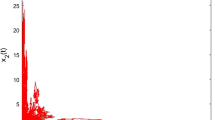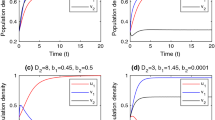Abstract
We give necessary and sufficient conditions for stochastically bounded coexistence in a class of models for two species competing in a randomly varying environment. Coexistence is implied by mutual invasibility, as conjectured by Turelli. In the absence of invasibility, a species converges to extinction with large probability if its initial population is small, and extinction of one species must occur with probability one regardless of the initial population sizes. These results are applied to a general symmetric competition model to find conditions under which environmental fluctuations imply coexistence or competitive exclusion.
Similar content being viewed by others
References
Abrams, P.: Variability in resource consumption rates and the coexistence of competing species. Theor. Popul. Biol. 25, 106–124 (1984)
Billingsley, P.: Convergence of probability measures. New York: Wiley 1968
Billingsley, P.: Weak convergence of measures: applications in probability. CBMS-NSF Regional Conference Series in Applied Mathematics 5. Society for Industrial and Applied Mathematics, Philadelphia, Pennsylvania (1971)
Breiman, L.: Probability. Menlo Park: Addison-Wesley 1968
Chesson, P. L.: Predator-prey theory and variability. Annu. Rev. Ecol. Syst. 9, 323–347 (1978)
Chesson, P. L.: The stabilizing effect of a random environment. J. Math. Biol. 15, 1–36 (1982)
Chesson, P. L.: Coexistence of competitors in a stochastic environment: the storage effect. In: Freedman, H. I., Strobeck, C.: (eds.) Population biology (Lect. Notes Biomath., vol. 52, pp. 188–198) Berlin Heidelberg New York Tokyo: Springer 1983
Chesson, P. L.: The storage effect in stochastic population models. In: Levin, S. A., Hallam, T. G.: (eds.) Mathematical ecology: Trieste Proceedings (Lect. Notes Biomath., vol. 54, pp. 76–89) Berlin Heidelberg New York Tokyo: Springer 1984
Chesson, P. L.: Environmental variation and the coexistence species. In: Case, T., Diamond, J.: (eds.) Community Ecology, pp. 240–256. New York: Harper and Row 1986
Chesson, P. L.: Interactions between environment and competition: how fluctuations mediate coexistence and competitive exclusion. In: Hastings, A.: (ed.) Community ecology (Lect. Notes Biomath., vol. 77) Berlin Heidelberg New York Tokyo: Springer: 1988
Connell, J. H., Sousa, W. P.: On the evidence needed to judge ecological stability or persistence. Am. Nat. 121, 789–824 (1983)
Ellner, S. P.: Asymptotic behavior of some stochastic difference equation population models. J. Math. Biol. 19, 169–200 (1984)
Ellner, S.: ESS germination strategies in randomly varying environments. I. Logistic-type models. Theor. Popul. Biol. 28, 50–79 (1985)
Ellner, S.: ESS germination strategies in randomly varying environments. II. Reciprocal-yield laws. Theor. Popul. Biol. 28, 80–116 (1985)
Ellner, S.: Alternate plant life history strategies and coexistence in randomly varying environments. Vegetatio 69, 199–208 (1987)
Grubb, P. J.: The maintenance of species richness in plant communities: the regeneration niche. Biol. Rev. 52, 107–145 (1977)
May, R. M.: On the theory of niche overlap. Theor. Popul. Biol. 5, 297–332 (1974)
May, R. M. (ed.): Theoretical ecology: principles and applications, 2nd edn. Boston: Blackwell 1981
Murdoch, W. W., Chesson, J., Chesson, P. L.: Biological control in theory and practice. Am. Nat. 125, 344–366 (1985)
Norman, F.: An ergodic theorem for evolution in a random environment. J. Appl. Probab. 12, 661–672 (1976)
Prout, T.: The delayed effect on fertility of preadult competition: two-species population dynamics. Am. Nat. 127, 809–818 (1986)
Prout, T., McChesney, F.: Competition among immatures affects their adult fertility: population dynamics. Am. Nat. 126, 521–558 (1985)
Sale, P. F.: Maintenance of high diversity in coral reef fish communities. Am. Nat. 111, 337–359 (1977)
Schaffer, W., Ellner, S., Kot, M.: The effects of noise on some dynamical models in ecology. J. Math. Biol. 24, 479–524 (1986)
Schaffer, W. M., Kot, M.: Chaos in ecological systems: the coals that Newcastle forgot. Trends Ecol. Evol. 1, 58–63 (1986)
Shmida, A., Ellner, S.: Coexistence of plant species with similar niches. Vegetatio 58, 29–55 (1985)
Slatkin, M.: The dynamics of a population in a Markovian environment. Ecology 59, 249–256 (1978)
Strong, D. R.: Density vagueness: abiding the variance in the dynamics of real populations. In: Diamond, J., Case, T. (eds.) Community ecology, pp. 257–268. New York: Harper and Row 1986
Tanner, J. T.: The stability and intrinsic growth rates of prey and predator populations. Ecology 56, 855–867 (1975)
Turelli, M.: Random environments and stochastic calculus. Theor. Popul. Biol. 13, 140–178 (1977)
Turelli, M.: Does environmental variability limit niche overlap? Proc. Natl. Acad. Sci. USA 75, 5085–5089 (1978)
Turelli, M.: Niche overlap and invasion of competitors in random environments. II. The effects of demographic stochasticity. In: Jager et al.: (eds.) Biological growth and spread, mathematical theories and applications, pp. 119–129 (1980)
Turelli, M.: Niche overlap and invasion of competitors in random environments I. Models without demographic stochasticity. Theor. Popul. Biol. 20, 1–56 (1981)
Turelli, M., Gillespie, J. H.: Conditions for the existence of stationary densities for some two dimensional diffusion processes with applications in population biology. Theor. Popul. Biol. 17, 167–189 (1980)
Underwood, A. J., Denley, E. L.: Paradigms, explanations, and generalizations in models for the structure of intertidal communities on rocky shores. In: Strong, D. R. Jr., Simberloff, D., Abele, L. G., Thistle, A. B.: (eds.) Ecological communities: conceptial issues and the evidence, pp. 151–180. Princeton: Princeton University Press 1984
Author information
Authors and Affiliations
Rights and permissions
About this article
Cite this article
Chesson, P.L., Ellner, S. Invasibility and stochastic boundedness in monotonic competition models. J. Math. Biology 27, 117–138 (1989). https://doi.org/10.1007/BF00276099
Received:
Revised:
Issue Date:
DOI: https://doi.org/10.1007/BF00276099




